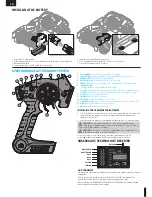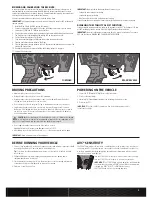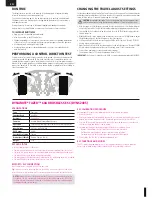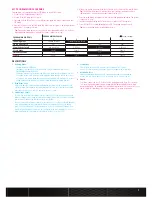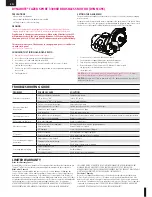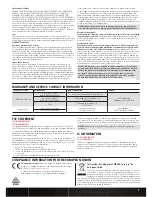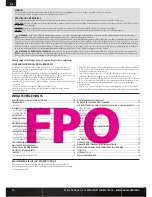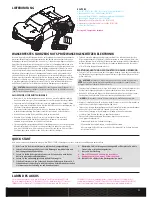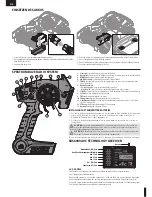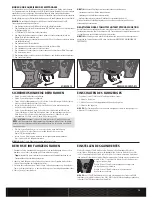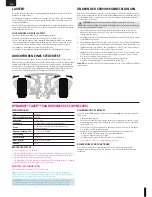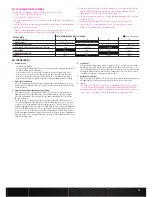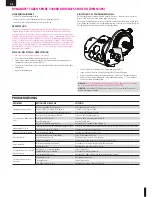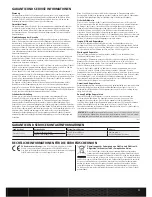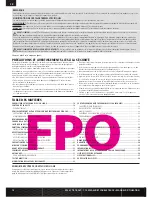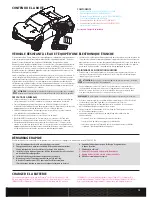
5
44$5353"7$8%4)035$0634&536$,t*/4536$5*0/."/6"-
DRIVING PRECAUTIONS
t
Maintain sight of the vehicle at all times.
t
Routinely inspect the vehicle for loose wheel hardware.
t
Routinely inspect the steering assembly for any loose hardware. Driving the vehicle
off-road can cause fasteners to loosen over time.
t
Do not drive the vehicle in tall grass. Doing so can damage the vehicle or electronics.
t
Stop driving the vehicle when you notice a lack of power. Driving the vehicle when
the battery is discharged can cause the receiver to power off. If the receiver loses power,
you will lose control of the vehicle. Damage due to an over-discharged Li-Po battery is
not covered under warranty.
CAUTION:
Do not discharge a Li-Po battery below 3V per cell. Batteries discharged
to a voltage lower than the lowest approved voltage may become damaged, result-
ing in loss of performance and potential fire when batteries are charged.
t
Do not apply forward or reverse throttle if the vehicle is stuck.
Applying throttle in this instance can damage the motor or ESC.
t
After driving the vehicle, allow the electronics to cool before driving the vehicle again.
IMPORTANT:
Keep wires away from all moving parts.
POWERING ON THE VEHICLE
1. Center the ST TRIM and TH TRIM dials on the transmitter.
2. Power on the transmitter.
3. Install a fully charged battery pack per the
Installing the Battery
section.
4. Power on the ESC.
IMPORTANT:
The vehicle MUST remain on a flat, level surface and motionless
for at least 5 seconds.
BEFORE RUNNING YOUR VEHICLE
1. Check for free suspension movement. All suspension arms and steering components should
move freely. Any binds will cause the vehicle to handle poorly.
Tip:
To increase the ride height and ground clearance of your vehicle, install the included
shock spacers.
2. Charge a battery pack. Always charge the battery pack as per the battery and/or
charger manufacturers’ instructions.
3. Set the transmitter steering trim. Follow the instructions to set the steering trim/subtrim
so that the vehicle drives straight with no input to the steering.
4. Perform a Control Direction Test.
AVC
®
SENSITIVITY
The ST RATE dial adjusts the sensitivity, or stability, value in the receiver. If you increase the
sensitivity, the AVC
®
system becomes more sensitive to the vehicle drifting left or right. You
would use maximum sensitivity during high speed driving or drag racing, when you want
the vehicle to stay in a straight line.
Turn the ST RATE knob counter-clockwise to reduce the sensitivity.
Turn the ST RATE knob clockwise to increase the sensitivity.
IMPORTANT:
The ST RATE knob will only adjust the sensitivity when
the transmitter is bound to a DSMR
®
receiver. When the transmitter
is bound to a DSM
®
, DSM2
®
or DSM Marine receiver,
the ST RATE knob controls the steering dual rate.
FORWARD
BRAKE/REVERSE
BINDING AND CALIBRATING THE RECEIVER
In order to operate, the receiver must be bound to the transmitter. Binding is the process of
programming the receiver to recognize the GUID (Globally Unique Identifier) code of a single
specific transmitter. When a receiver is bound to a transmitter/model memory, the receiver will
only respond to that specific transmitter/model memory.
You must calibrate the receiver each time it is placed in bind mode.
IMPORTANT:
The following sequence of steps must be followed in order for AVC technology to
function properly.
1. Insert the Bind Plug in the BIND port on the receiver.
2. Power on the receiver. The orange LED flashes, indicating the receiver is in bind mode.
3. Center the ST TRIM and TH TRIM on the transmitter.
4. Put your transmitter in bind mode by powering on transmitter while holding down bind button.
5. The bind process is complete when the orange LED on the receiver is solid.
6. Pull the transmitter trigger to Full Throttle.
7. Push the transmitter trigger to Full Brake, then return the trigger to center.
8. Turn the transmitter steering wheel to Full Right.
9. Turn the transmitter steering wheel to Full Left, then return the steering wheel to center. The
orange LED flashes once.
10. Remove the bind plug once the calibration and binding process is complete.
11. Power off the transmitter.
IMPORTANT:
You must rebind the transmitter and receiver if you:
t
Change the servo reverse after binding
t
Change the travel after binding
t
Want to use the receiver with a different model memory
If you change the servo reversing or travel adjust after binding, AVC will not work properly.
DISABLING THE STABILITY ASSIST FUNCTION
If you participate in organized racing, you may be required to turn AVC
®
technology off. To turn
off AVC technology, insert a second Bind Plug in the Disable port before binding.
IMPORTANT:
You must calibrate the receiver each time it is placed in bind mode. To activate
AVC, see the steps in BINDING AND CALIBRATING THE RECEIVER.


